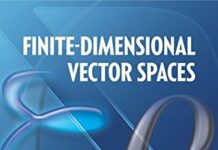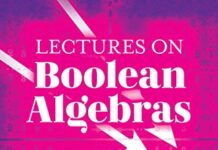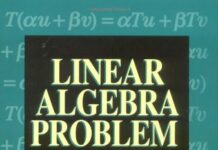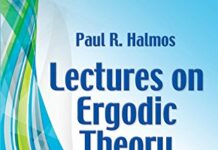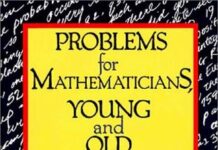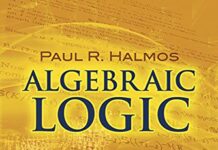
Ebook Info
- Published: 1950
- Number of pages: 316 pages
- Format: PDF
- File Size: 8.68 MB
- Authors: Paul R. Halmos
Description
Useful as a text for students and a reference for the more advanced mathematician, this book presents a unified treatment of that part of measure theory most useful for its application in modern analysis. Coverage includes sets and classes, measures and outer measures, Haar measure and measure and topology in groups. From the reviews: “Will serve the interested student to find his way to active and creative work in the field of Hilbert space theory.” –MATHEMATICAL REVIEWS
User’s Reviews
Editorial Reviews: Review P.R. HalmosMeasure Theory”As with the first edition, this considerably improved volume will serve the interested student to find his way to active and creative work in the field of Hilbert space theory.”―MATHEMATICAL REVIEWS
Reviews from Amazon users which were colected at the time this book was published on the website:
⭐Halmos has written a classic work on measure theory that at the time of its publication was the authoritative textbook in measure theory. It is a joy to read, because it is so clearly and concisely written. Some more modern texts feature more recent developments and are written in a very different manner than Halmos’ book, thus reflecting those newer developments. While these more modern texts supplant Halmos’ book, becaue Halmos is such a classic, it is a superlative guide to just those measure theoretic ideas needed for an elementary appreciation of the subject. I studied from a competitor’s text and later read Halmos’ book and found it to be superior. I certainly learned a great deal more from Halmos than I could find in any other book on measure theory. My study of Halmos took place in the early 80’s. Much progress has been over the last 40 years and modern texts reflect this progress. Thus Halmos’ is largely of historical importance today. But, as a classic, it is still worth reading.
⭐It is a used one but like a new book. The content is classic, necessary for anyone who likes mathematics.
⭐Not exactly clear at times. A bit sparse on explanation, even in the proofs. Very much have to have already seen it all beforehand before delving into this text…
⭐This book is an overview of measure theory that is somewhat dated in terms of the presentation, but could still be read profitably by someone interested in studying the subject with greater generality than more modern texts. Measure theory has abundant applications, and has even gained importance in recent years in such areas as financial engineering. Those interested in the applications of measure theory to financial engineering should choose another book however, since this one does not even mention the word martingale. After a review of elementary topology and set theory in chapter 1, the author begins to define the elementary notions of measure theory in chapter 2. His approach is more general than other texts, since he works over a ring instead of an algebra. Measures on intervals of real numbers is given as an example. Measures and outer measures are defined, and it is shown how a measure induces an outer measure and how an outer measure induces a measure. The next chapter explores more carefully the relation between measures and outer measures. It is also shown in this chapter to what extent a measure on a ring can be extended to the generated sigma-ring. The all-important Lebesgue measure is developed here also, and the author exhibits an example of a non-measurable set. In order to develop an integration theory, one must first characterize the collection of measurable functions, and the author does this in chapter 4. The convergence properties of measurable functions are carefully outlined by the author. The theory of integration begins in chapter 5, wherein the author follows the standard construction of an integral by first defining integrals over simple functions. Then in chapter 6, signed measures are defined, and the Lebesgue bounded convergence theorem is proven and the Hahn and Jordan decompositions of these measures are discussed. The all-important Radon-Nikodym theorem, which gives an integral representation of an absolutely continuous sigma-finite signed measure, is proven in detail. One can of course take the Cartesian product of two measurable spaces, and the author shows how to define measures on these products in chapter 7, including infinite products. The physicist reader may want to pay attention to the section on infinite dimensional product measures, as it does have applications to functional integration in quantum field theory (although somewhat weakly). The author treats measurable transformations in chapter 8, but interestingly, the word “ergodic” is never mentioned. He also introduces briefly the L-p spaces, so very important in many areas of mathematics, and proves the Holder and Minkowski inequalities. The next chapter is the most important in the book, for it covers the notion of probability on measure spaces. After an brief motivation in the first section of the chapter, probability spaces are defined, and Bayes’ theorem is discussed as an exercise. Both the weak and strong law of large numbers is proven in detail. Things get more abstract in chapter 10, which discusses measure theory on locally compact spaces. Borel and Baire sets on these kinds of spaces are defined, and the author gives detailed arguments on what must be changed when doing measure theory in this more general kind of space. The book ends with a discussion of measure theory on topological groups via the Haar measure. This chapter also has connections to physics, such as in the Faddeev-Popov volume measure over gauge equivalent classes in quantum field theory. The author does a fine job of characterizing the important properties of the Haar measure.
⭐There comes a time when the budding probabilist or statistician seeks a more comprehensive treatement of measure theory than is afforded in the first few sections of a graduate text in pstats. I chose Halmos’s “Measure Theory” for this purpose for two primary reasons: i) Paul Halmos in my opinion is one of the best expository mathematics writers in history, and ii) years ago I paid $1 for the above-mentioned text (original Van Nostrand print) at a local thriftstore. My only perceived drawback was that likely some of his approach to measure theory may be outdated.After reading the text (up to the chapter on probability) my opinion of Halmos as a writer and mathematician not only has been elevated, but the book delivered the thorough study of measure theory that I had hoped for. Indeed, the author does an excellent job in presenting measure theory in its entire generality semi-rings, rings, hereditary rings, algebras, sigma algebras and their extensions are all considered in detail, as well as measures on these set systems: finitely additive , sigma additive, inner measures, outer measures, sigma-finite measures, the completion of measures, regular measures). I especially enjoyed his presentation of Fubini’s Theorem along with the concept of “section of a measurable set”, which helped the theorem fall out effortlessly. I also found his presentation of different types of convergence (e.g. pointwise, uniform, almost uniform, in measure, in mean) very good and helped give me the bigger picture on modes of convergence. Theorem 22A is essentially a generalization of the Borel-Cantelli Lemma.The book does have a few downsides. In particular pi and lambda-systems are not used and in some sense replaced by the older notion of semiring. Also, the author’s definition of Lesbegue integrable seemed a bit more complicated than what is usually presented (e.g. for nonnegative measurable f to be integrable it requires a sequence fn of simple functions that is mean fundamental and converges in measure to f; compare this with the simpler definition of the integral of measurable f being the sup of Lesbegue integrals of simple functions g for which g <= f). But I consider these downsides minor and highly recommend this text to anyone who seeks a deeper understanding of measure theory.My impression of measure theory has gone from seeing it as abstract mathematical machinery for simplifying analysis proofs, to a kind of mathematical philosophy that unifies the infinite with the discrete, and lays the proper foundations for inference, probabilistic reasoning, and learning; i.e. the foundations of cognitive intelligence. ⭐Halmos was a lucid mathematical writer but his "Measure Theory" is dated 1950 and so antedates by two years Rohlin's definitive axiomatic discussion in Doklady Nauk USSR 1952. The attempted axiomatization by Halmos and Von Neumann in the the late 1940's failed and was withdrawn by its authors. Someone who is seriously interested to learn measure theory, with an approach based on the notion of measureable homomorphism, should visit Rohlin's publications and at least one other modern book.WH Cobbs Narberth PA ⭐Is it india student copy? The text is blur. This is unacceptable.Irresponsible seller. ku oc xomom ⭐El contenido esta a la altura ya que es in clásico, sin embargo mi calificación es por la calidad de la impresión y empastado, hojas de calidad mediocre, pegadas con pegamento regular y pasta igualmente mediocre, nada que ver con la antigua calidad de sus libros con hojas laminadas y cosidas. Por el precio está más o menos bien, lo compré en poco más de cuatrocientos pesos, aunque ahorrandose esos costos podría ser más barato aún, estaría muy bien que pudiesen dar a elegir opciones de impresión, no quisiera ser de esas personas que pagan mil o más y reciben lo que recibí yo.Très satisfaisant ⭐
Keywords
Free Download Measure Theory (Graduate Texts in Mathematics, 18) in PDF format
Measure Theory (Graduate Texts in Mathematics, 18) PDF Free Download
Download Measure Theory (Graduate Texts in Mathematics, 18) 1950 PDF Free
Measure Theory (Graduate Texts in Mathematics, 18) 1950 PDF Free Download
Download Measure Theory (Graduate Texts in Mathematics, 18) PDF
Free Download Ebook Measure Theory (Graduate Texts in Mathematics, 18)
